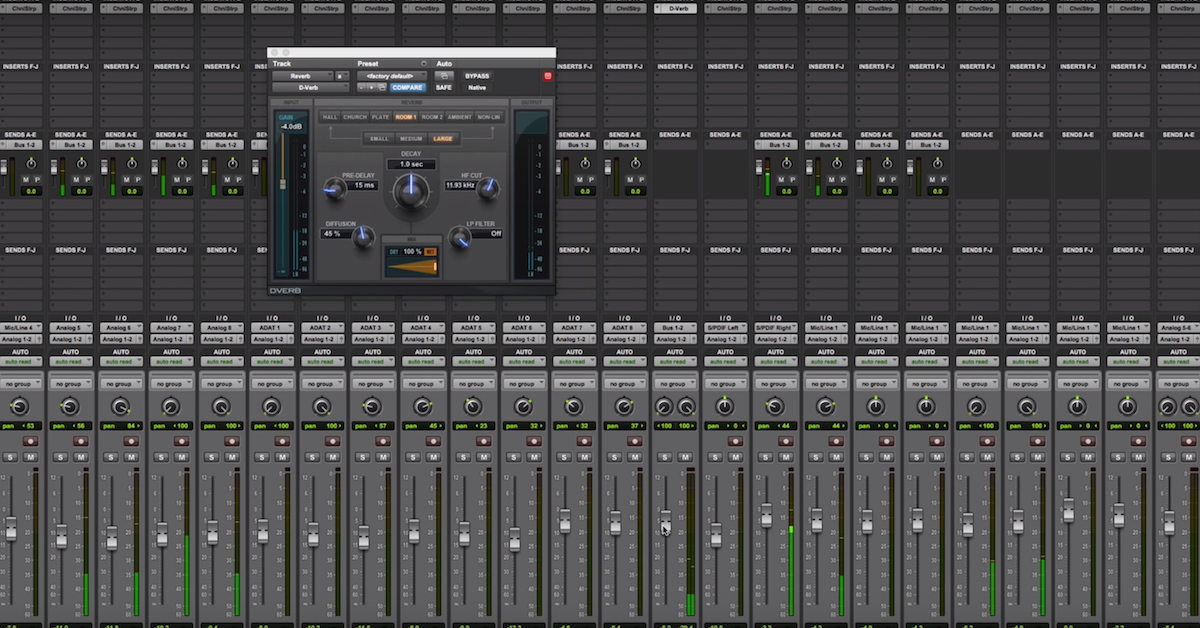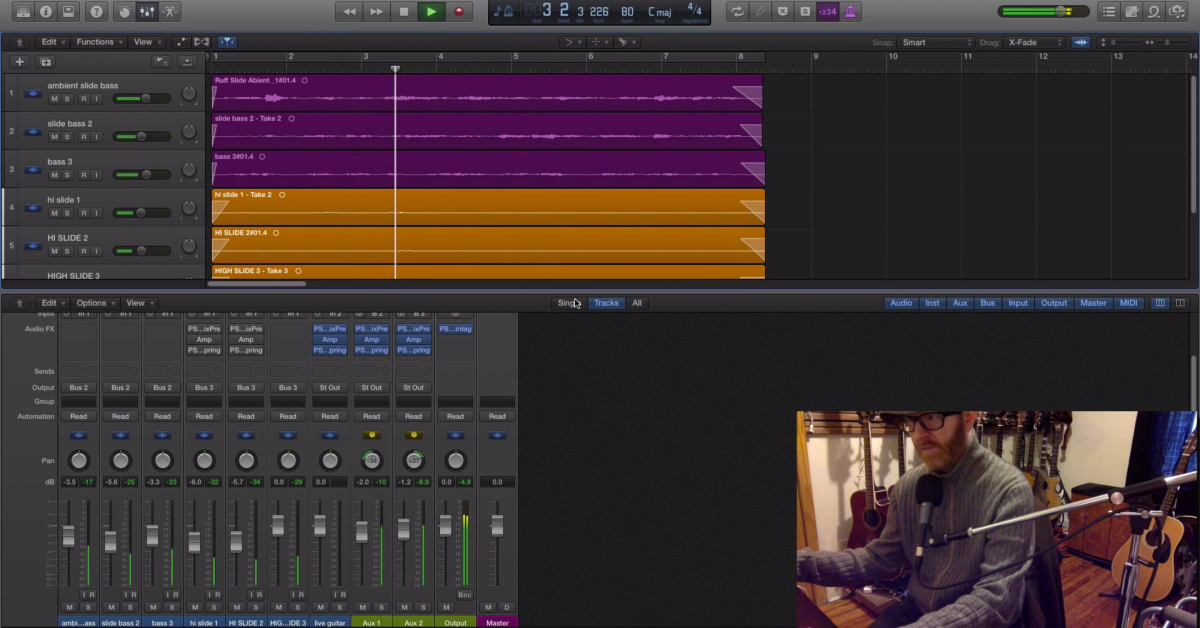11 Things to Do with Guitar and Reverb
Article Content
1. Spring Reverb
This is the most obvious use of reverb for guitarists. Surf music popularized spring reverb. Spring reverbs have a very specific sound that is hard to recreate digitally.
Although two spring reverb plugins I like for general uses are the PSP SpringBox and the UAD AKG BX20, for an electric guitar I still prefer to use reverb before or in the amp. There is a relationship that just can’t be recreated in post.
For outboard spring reverb, you could use a Blackface Fender Reverb amp or an external tube spring reverb unit like the Valve Train Spring Thing. In my opinion, the true sound of surf guitar is an external tube spring reverb running into a hot amp. Add a Stratocaster and you have instant Dick Dale vibe!
Here are some examples of a single chord hit with different spring reverbs.
Signal Chain:
1964 Guild Starfire with DeArmond humbuckers into a Headstrong Lil King miked with an AEA A 840 ribbon into a UAD Apollo.
Valve Train Spring Thing
Anasounds Element
Demeter Reverbulator
Headstrong Lil King Reverb
Spring reverb doesn’t just have to be used for surf music. I really like using the Demeter Reverbulator real spring reverb pedal on ambient guitar parts. This pedal can give you the essence of the spring but not sound as sproingy as the reverb on a Twin Reverb.
1964 Guild Starfire with DeArmond humbuckers, Maestro FZ-1A fuzz into a Headstrong Lil King miked with an AEA A 840 ribbon into a UAD Apollo.
Gibson ES-335 with Florence ‘59 humbuckers and 50’s wiring into a Headstrong Lil King miked with an AEA A 840 ribbon into a UAD Apollo.
80’s Vibes
Signal Chain:
Fender ’52 Reissue Telecaster with Florence ‘52 pickups into a Headstrong Lil King miked with an AEA A 840 ribbon into a UAD Apollo.
2. Plate Reverb
Plate reverbs can also be a great tool for single-note lines or ambient pads when you want something with a little more character. Springs and plates tend to pop a little more than halls. I also associate plate reverb with some of the ambient gritty guitar textures from the Ennio Morricone Spaghetti Western era.
I often use the UAD EMT 140 plate plugin. These can create great ghostly reverbs.
Signal Chain:
Fender American Strat with FSC ’59 pickups, Death By Audio Evil Filter into a Victoria 35115 amp miked with an AEA A 840 ribbon into a UAD Apollo with UAD EMT 140 reverb plugin.
3. Swell Reverb
The Strymon Big Sky has the option to use a swell reverb. It swells in the note of the chord you play into a lush wide reverb. Unlike a reverse reverb, it doesn’t cut the trail when full volume has been reached.
Signal Chain:
Gibson ES-335 with Florence ’59 Humbuckers and 50’s wiring, Strymon Big Sky into a Victoria 518 miked with a Sennheiser e906 into a UAD Apollo.
4. Loop Reverb Tweaker
Creating a droning loop and running it through a reverb can give you the ability to tweak the parameters of the reverb in real-time to augment the tone.
I like doing this for ambient pads. You can find me adjusting everything from diffusion and EQ to dwell and size. This can attain some dreamy soundscapes that seem to move like waves in the ocean as opposed to staying still.
Signal Chain:
Fender Stratocaster with FSC ’59 pickups into the TC Electronic Ditto, Strymon Big Sky into a Vox AC15 miked with a Soyuz Bomblet into a UAD Apollo.
Parameters
Speaking of this, let’s listen to the various parameters that are often found on a reverb. I’m going to use the Strymon Big Sky for reference.
Hall:
Studio:
Club:
Decay:
Pre Delay:
Diffusion:
5. Odd Spaces
Don’t get caught in the trap of only choosing traditional reverbs. Hall, chambers and plates are lovely. But, sometimes you need something that perks your ears up. An unconventionally shaped space can do this for you. It could be the perfect reverb for a low single note line on a guitar that is driving a section in a song. Adding some character can really highlight an arrangement sometimes.
6. Infinite Sustain
Another feature I like about the Styron Big Sky is the infinite sustain feature. This allows you to hold down the footswitch and sustain the dwell of the reverb.
It’s almost like having a Freeze option built into a reverb. Although it sounds more natural than an Electro Harmonix Freeze.
It’s a cool alternative to riding the feedback knob on a tape echo. You can create nice pads that seem to sit still more than using a delay for swirling pads.
Signal Chain:
Gibson ES-335 with Florence ’59 Humbuckers, Strymon Big Sky into a Victoria 318 miked with a Sennheiser e 906 into a UAD Apollo.
7. Reverb as a Delay
Did you know that you can play with the pre-delay on a reverb to create a reverb-like slapback? This can yield a very different aural experience than using a delay.
I’ve done everything from slapback, 8th note or even quarter note delays with reverb. Time to experiment with the pre-delay knob!
8. Saturating Reverb
Sometimes I like to process the reverb send separately. I can either do this post-recording or I can use the AmpRX Apparition to blend in my processed reverb chain with my clean signal.
I may filter the reverb or compress it or even overdrive it. Putting an overdrive pedal after a reverb is going to bring out some interesting harmonics.
When you push a tube amp hard with real spring reverb, you may not realize it, but you’re are also saturating the reverb. If you listen, you’ll notice your reverb sounds a little different on 3 then on 7 with a real spring reverb in an amp circuit.
9. Room Reverb for a Fatter Tone
The challenge with home recording is getting a wide sound on the guitar. Often you’ll find project studio recordists placing one close mic on the cab and running with it.
Although this is fine in some applications, you may feel your guitar sounds a bit narrow. If your room doesn’t sound good, putting up a room mic is going to be more trouble than it’s worth.
To help widen the sound we can add a room reverb in the mono mic. We can use a plugin like the UAD Ocean Way to essentially reamp our guitar cab into a different room (and treat it like a second mic) or we can use a room reverb preset on another reverb.
I prefer Ocean Way personally, but any room reverb can help. Often the trick is to blend in carefully with your single mono mic unless you’re going for that big room sound. But, simply tucking it in to almost where you don’t hear it can still give you the directness of the close mic but the width of the “room” sound.
In this example, I have the clean mic panned left. I copied that track, placed the UAD Ocean Way on it at fully wet and panned it far right.
Signal Chain:
Gibson ES-335 with Florence ’59 Humbuckers into a Victoria 318 miked with a Sennheiser e 906 into a UAD Apollo with the UAD Ocean Way Plugin.
One other trick is to actually record a second mic on your amp and only send that to a reverb. Check out this example where the close mic Sennheiser e 906 is left and dry while the right mic (Soyuz Bomblet as a room mic) is sent to a UAD EMT 140 plate. This can create an interesting dimension. Notice that I’m not sending the room mic to a stereo send for reverb. It’s a mono reverb panned with the room mic that’s feeding it.
Stereo reverbs can be overwhelming sometimes. I encourage you to experiment with some mono reverbs that you can pan.
10. Chamber Reverb
Recently I’ve really been getting into Chamber Reverb. I’ve been using the UAD Capitol Chambers. This reverb has been used on countless recordings we all adore. It’s a really pleasing reverb for all instruments. I really like it for acoustic and electric guitars.
Signal Chain:
Fender ’52 Reissue Tele with Florence ’52 pickups into a Headstrong Lil King miked with an AEA A 840 ribbon into a UAD Apollo with the UAD Capitol Chambers plugin.
11. Reverse Reverb
For a little 1980’s spice, you could use some reverse reverbs that swell into a chord hit or note. It’s pretty easy to do. Simply record a chord hit with a lot of reverb. Then reverse it! You can hear this effect in this example. Also added a tape echo after the hard chord hit for a different effect.
Signal Chain:
Gibson ES-335 with Florence ’59 Humbuckers, into a Victoria 318 miked with a Sennheiser e 906 into a UAD Apollo with the AMS RMX16 reverb and UAD EP-34 plugin.
You can do a lot of fun things with reverb! It can add a lot of flavor to your music and it doesn’t always have to wait until mixing. Pairing the right reverb with your electric or acoustic guitar can be as important as picking the guitar itself.
Listen carefully to the character of each reverb you try. Consider how it interacts with the music and do a little research to find out what reverbs were used in music that inspires you.





